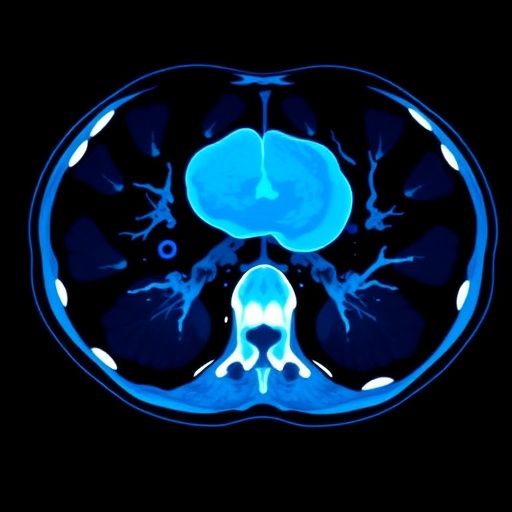
A groundbreaking study conducted in Denmark has unveiled compelling evidence that men with biochemically recurrent prostate cancer experience markedly improved overall survival rates when evaluated with PSMA PET/CT imaging prior to undergoing salvage radiotherapy. This landmark analysis, drawing on nationwide data collected over an eight-year span, reflects real-world clinical practice and offers unprecedented insight into the transformative potential of molecular imaging in personalized cancer therapy. Published in the August 2025 issue of The Journal of Nuclear Medicine, the findings represent a pivotal advancement in the management of recurrent prostate malignancies.
Prostate cancer, one of the most prevalent malignancies among men globally, frequently resurfaces following radical prostatectomy. Biochemical recurrence, characterized by rising prostate-specific antigen (PSA) levels, poses a significant clinical challenge, occurring in approximately 40% of patients post-surgery. Traditional imaging modalities such as bone scintigraphy, CT, and MRI have historically been used to localize such recurrences, guiding salvage radiotherapy interventions aimed at eradicating residual disease. However, these methods often lack the sensitivity necessary to detect early metastatic or locoregional recurrence.
PSMA PET/CT—prostate-specific membrane antigen positron emission tomography/computed tomography—has emerged as a cutting-edge diagnostic technique, offering unparalleled sensitivity and specificity in visualizing prostate cancer lesions at low PSA levels. PSMA, a transmembrane protein highly expressed in prostate cancer cells, serves as a target for radiotracers that illuminate cancerous tissue during PET imaging. This capability facilitates precise anatomical localization, enabling clinicians to tailor salvage radiotherapy plans with greater accuracy than was previously achievable.
.adsslot_hpZ80jQwSH{width:728px !important;height:90px !important;}
@media(max-width:1199px){ .adsslot_hpZ80jQwSH{width:468px !important;height:60px !important;}
}
@media(max-width:767px){ .adsslot_hpZ80jQwSH{width:320px !important;height:50px !important;}
}
ADVERTISEMENT
Despite the widespread acceptance of PSMA PET/CT for enhancing diagnostic clarity, until now, the critical question remained: does employing PSMA PET/CT prior to salvage radiotherapy translate into concrete survival benefits? Addressing this knowledge gap, lead researcher Anna W. Mogensen and colleagues at Aalborg University Hospital leveraged Denmark’s comprehensive, nationwide health registries to conduct an observational cohort study involving 844 patients treated with salvage radiotherapy between 2015 and 2023.
The cohort was bifurcated into two groups; 308 patients underwent pretreatment PSMA PET/CT imaging, while 536 patients did not. Rigorous statistical analyses assessed overall survival and biochemical recurrence-free survival outcomes over a follow-up period extending to five years post-therapy. The study utilized robust endpoints, including one-, two-, and five-year survival metrics, to ascertain the clinical impact of PSMA PET/CT-guided interventions.
Remarkably, the analysis revealed that patients receiving PSMA PET/CT prior to salvage radiotherapy demonstrated significantly higher survival rates. Specifically, the one-year survival rate for the PSMA PET/CT group reached 100%, slightly edging the 99% observed in the non-PSMA group. More importantly, at two years, survival was 99.5% versus 97.8%, and at five years, 98.1% compared to 93.8%, respectively. These survival advantages underscore the prognostic value of incorporating molecular imaging into therapy decision-making for recurrent prostate cancer.
Moreover, biochemical recurrence-free survival at three years further corroborated these findings: 74.9% for patients who underwent PSMA PET/CT versus 69.4% in the comparison group. Biochemical recurrence-free survival is a crucial prognostic indicator, reflecting successful suppression of cancer activity following treatment. These data collectively suggest that PSMA PET/CT not only guides more effective salvage radiotherapy planning but also contributes meaningfully to long-term disease control.
The implications of these results extend beyond survival statistics, emphasizing a paradigm shift in oncologic care. By providing refined visualization of recurrent cancer loci, PSMA PET/CT empowers clinicians to select patients who are most likely to benefit from salvage radiotherapy, thereby sparing others from potentially unnecessary or ineffective treatment. This tailored therapeutic approach aligns with the principles of precision medicine, aiming to optimize clinical outcomes while minimizing adverse effects and healthcare costs.
Anna W. Mogensen highlights that PSMA PET/CT was incrementally implemented across Danish regions beginning in 2015, creating a natural experiment environment whereby comparative outcome analysis became viable. This staggered adoption allowed researchers to draw inference from real-world data, reflecting routine clinical practices rather than controlled clinical trial settings. Consequently, the study’s findings hold significant external validity and relevance for broader healthcare systems contemplating integration of PSMA PET/CT imaging.
From a technical perspective, PSMA PET/CT combines the anatomical resolution of computed tomography with the functional imaging capabilities of positron emission tomography. Radiolabeled ligands targeting PSMA bind selectively to prostate cancer cells, emitting positrons detectable by the PET scanner. This fusion imaging technique detects both soft tissue and bone metastases with high precision, often revealing sites of spread previously occult to conventional imaging. As a result, radiation oncologists can deliver high-dose radiotherapy to defined targets while sparing healthy tissues, potentially improving therapeutic indices.
The study capitalizes on Denmark’s well-established national health registries, renowned for their comprehensive and longitudinal data capture. Such resources enabled investigators to track patient demographics, treatment modalities, imaging utilization, and survival outcomes over extensive periods. This population-level approach provides critical insights unattainable via smaller-scale studies, reinforcing the robustness and generalizability of conclusions pertaining to PSMA PET/CT’s clinical utility.
Importantly, the findings suggest that early incorporation of PSMA PET/CT into the diagnostic workflow for biochemically recurrent prostate cancer could become a new standard in oncology practice worldwide. As molecular imaging technologies continue to evolve, integrating these tools prospectively within treatment algorithms promises to enhance personalized cancer management, ultimately improving survival and quality of life for patients.
The authors of this impactful study represent a multidisciplinary team from several Danish institutions, including Aalborg University Hospital and Aarhus University Hospital, combining expertise in nuclear medicine, clinical epidemiology, oncology, and clinical cancer research. Their collaboration exemplifies the critical intersection of cutting-edge imaging, epidemiological rigor, and clinical oncology needed to drive innovation in cancer care.
In conclusion, this comprehensive real-world study confirms that pretreatment PSMA PET/CT significantly improves overall survival outcomes in men with biochemically recurrent prostate cancer undergoing salvage radiotherapy. These results not only affirm the diagnostic superiority of PSMA PET/CT but also establish its vital role in optimizing therapeutic strategies. As clinicians and health systems worldwide grapple with the challenges of recurrent prostate cancer management, this evidence strongly advocates for the widespread adoption of PSMA PET/CT to guide salvage treatment and improve patient prognoses.
Subject of Research: The impact of PSMA PET/CT imaging on survival outcomes in men with biochemically recurrent prostate cancer treated with salvage radiotherapy.
Article Title: The Use of PSMA PET/CT Improves Overall Survival in Men with Biochemically Recurrent Prostate Cancer Treated with Salvage Radiotherapy: Real-World Data from an Entire Country
News Publication Date: August 13, 2025
Web References:
Journal of Nuclear Medicine
DOI link
Image Credits: Image created by HD Zacho and AW Mogensen et al., Aalborg University Hospital, Aalborg, Denmark.
Keywords: Molecular imaging, Medical imaging, Positron emission tomography, Prostate cancer
Tags: advanced diagnostic techniques for prostate cancerbiochemical recurrence in prostate cancerclinical practice in cancer treatmentimproving outcomes in recurrent prostate cancerJournal of Nuclear Medicine prostate cancer findingsmolecular imaging in cancer therapynationwide study on prostate canceroverall survival rates in prostate cancerprostate cancer management strategiesPSMA PET/CT imagingsalvage radiotherapy for prostate cancersensitivity of imaging modalities





